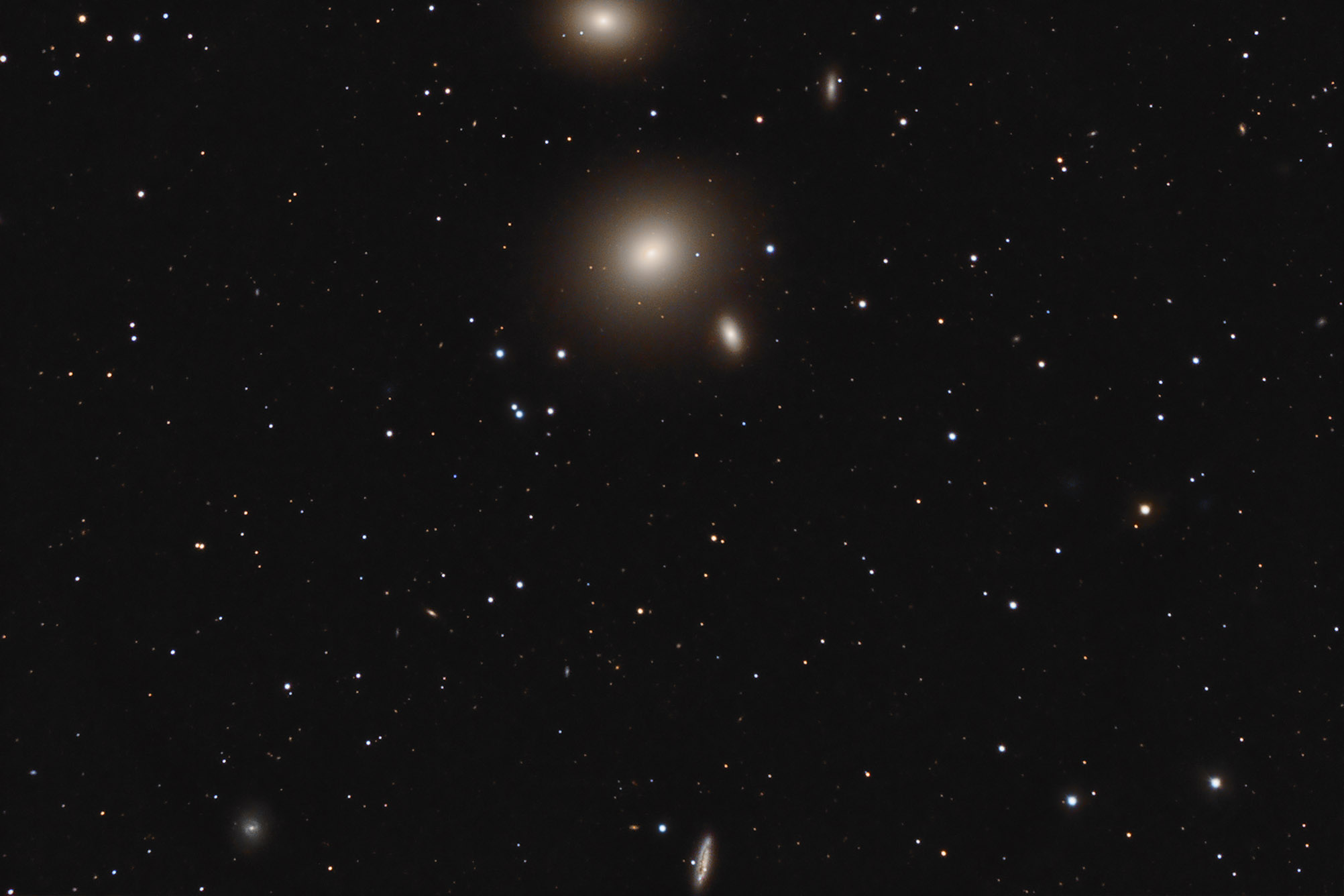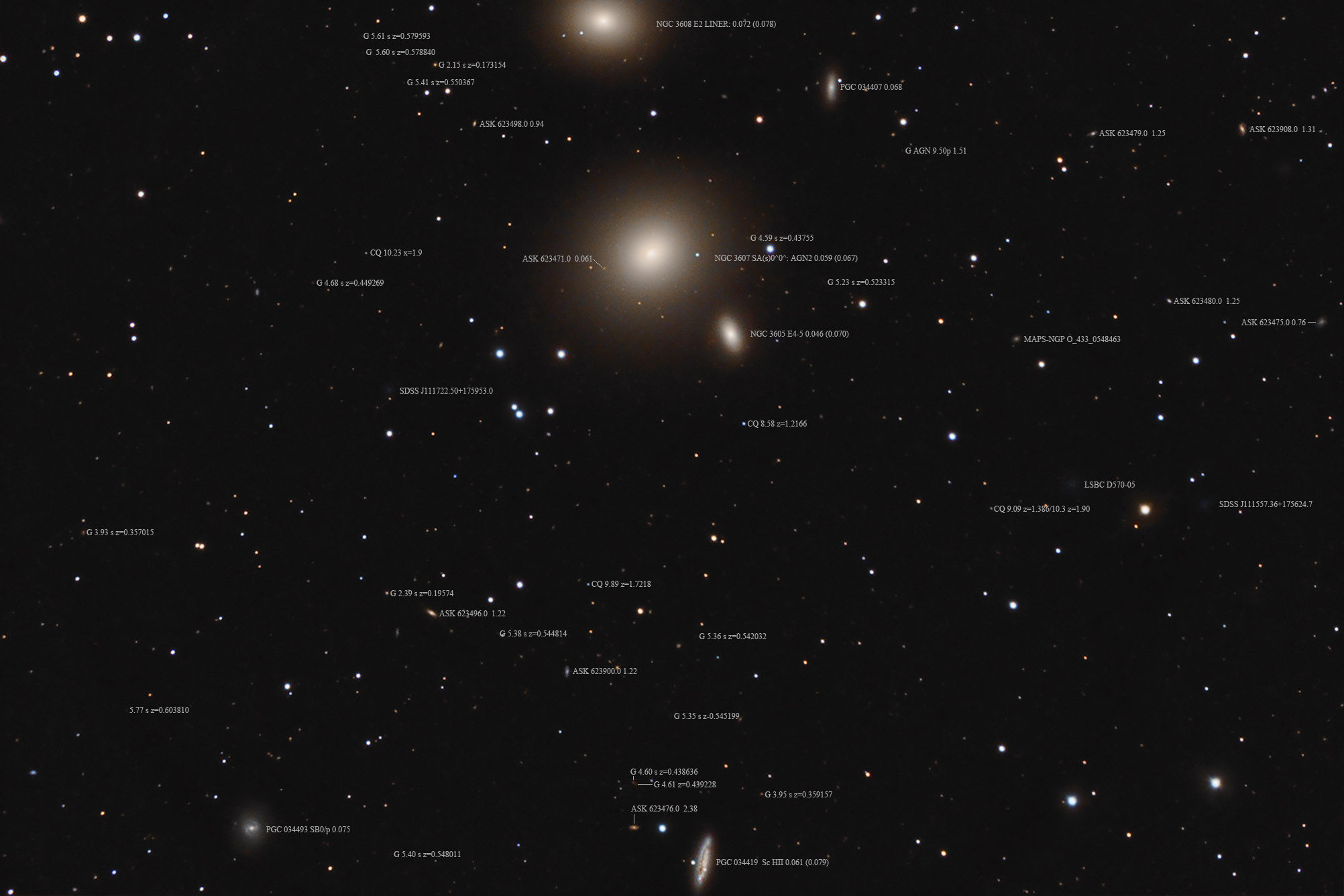| Description | Images |
Object name: NGC3607Designation(s): NGC3607, NGC3605, NGC3608, The NGC 3607 group consists mostly of elliptical or elliptical-like galaxies with spirals limited to the edges. It is about 50 to 70 million light-years away and located in the hindquarters of Leo the Lion. The entire group doesn't fit my field. I was going to center on NGC 3607 but the two spirals well to the south caught my eye. I couldn't quite fit NGC 3608 in and them too without rotating my camera. As it was -30C the night I took this and I don't have an electrical rotator that didn't happen. Ellipticals aren't often as interesting as spirals so I opted to cut off the elliptical. Also, I couldn't quite fit in NGC 3599 an SA0: member of the group that was just too far west and still fit in PGC34493 which seemed more interesting to me though a lot smaller. The f/8 version of this scope came out several years after I bought the f/10 version. It would have had the field I need. Consult the annotated image for other galaxies in the 50 to 70 million light-year range for others in the group. Related Designation(s):1RXS J111659.1+180306, 1WGA J1116+1803, 1XMM J111659.0+180853, 2MASS J11164658+1801017, 2MASS J11165467+1803062, 2MASS J11165896+1808551, 2MASX J11164662+1801017, 2MASX J11165465+1803065, 2MASX J11165896+1808547, 2MASXi J1116466+180101, 2MASXi J1116542+180309, 2MASXi J1116588+180854, 2XMM J111654.7+180307, 2XMM J111659.1+180851, 2XMMp J111654.7+180307, 2XMMp J111659.1+180851, AKARI J1116543+180311, ASK 623482.0, CGCG 096-019, CGCG 096-021, CGCG 096-022, CGCG 1114.1+1817, CGCG 1114.3+1819, CGCG 1114.4+1825, CXO J111654.6+180305, CXO J111654.67+180304.5, CXO J111658.9+180854, CXO J111658.91+180854.7, CXOU J111654.6+180305, GALEXASC J111646.69+180101.7 , GALEXASC J111658.93+180855.6 , GALEXMSC J111646.68+180102.9 , GALEXMSC J111658.95+180855.1 , HDCE 0632 NED010, HDCE 0632 NED012, HDCE 0632 NED013, HOLM 240A, HOLM 240B, HOLM 240C, ISOSS J11169+1802, KPG 278A, KPG 278B, LDCE 0778 NED028, LDCE 0778 NED030, LDCE 0778 NED031, LGG 237:[G93] 012, LQAC 169+018 002, MCG +03-29-019, MCG +03-29-020, MCG +03-29-022, NFGS 080, NGC 3605, NGC 3607, NGC 3607:[L2011a] X0004, NGC 3608, NGC 3608:[L2011a] X0001, NGC3605, NGC3607, NGC3608, NSA 112063, NSA 139082, NSA 159561, NVSS J111654+180304, PGC 034415, PGC 034426, PGC 034433, RSCG 40:[WBJ2013] A, RSCG 40:[WBJ2013] B, RSCG 40:[WBJ2013] D, RX J1116.9+1808, SDSS J111646.58+180101.7, SDSS J111646.59+180101.7, SDSS J111654.63+180306.3, SDSS J111658.95+180855.2, SSTSL2 J111646.60+180102.5, SSTSL2 J111658.95+180855.8, UGC 06295, UGC 06297, UGC 06299, USGC U376 NED11, USGC U376 NED12, USGC U376 NED14, UZC J111646.6+180101, UZC J111654.7+180306, UZC J111659.0+180855, v2MCG 41:[DMP2012] 1, v2MCG 41:[DMP2012] 2, v2MCG 41:[DMP2012] 4, WBL 319-001, WBL 319-002, WBL 319-003, XBS J111654.8+180304, [AHG2014] B156, [BEC2010] HRS 043, [GMM2009b] 24, [GMM2009b] 25, [M98j] 115 NED02, [M98j] 115 NED04, [M98j] 115 NED05, [SGT2004] J111654.64+180304.1 , [SLK2004] 0608, [VPP2013] 09, |

